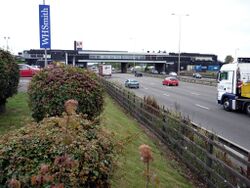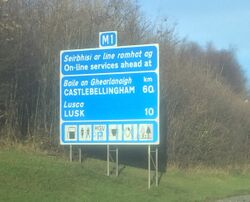Online services

An online service area is one which is built immediately adjacent to the road it serves, so drivers can literally pull in straight off the motorway. The standards prefer this design to offline services, but not everybody agrees.
Most of the UK's examples of this design have facilities on both sides of the road, but only because our service areas tend to handle large volumes of people. When the motorways were quieter, it was common to provide facilities on one side of the bridge only.
Since 2008 there has been a preference for this design of service area; the 2022 policy made it stronger and said they are "more conducive to encouraging drivers to stop". Until the 1970s, it was the only design ever considered, unless there was absolutely no other option available. As operators and developers were given increasingly more say in the design of new service areas, they would ask for this design not to be built as it has higher running costs and a smaller catchment area; their preference persists even though the regulations try to discourage it.

In Ireland, the phrase is used publicly, with signs providing information about "on-line" and "off-line" services. "Online" is often used as a euphemism for "official" or "government-designed", and that is true on the motorways, but there are a few exceptions elsewhere.
Down-sides
Most customers will tell you they prefer online service areas because they are easier to find, and they mean you don't get caught up in traffic at the junction. This is true, but there are a few negatives.
Firstly, if you have a busy road which already has several exits, adding another exit for a service area can make things complicated and confusing. At Hilton Park, there isn't much space to tell drivers about the service area because of the big exit for the M54 immediately before. At Chieveley, there is a long history of people getting confused and taking the wrong exit.
Secondly, introducing a new exit to a high-speed road introduces new safety risks. This can be avoided if you take advantage of a junction that already exists. The problem is this is only true if the junction has plenty of spare capacity, and in the UK most of our motorway junctions are already congested and accident-prone.
Drivers will often comment that the exits from service areas, when they lead straight to the main road, are usually far too short. This can be avoided if you're using a junction that is already built to a high standard, and it means the developer won't have to worry about the cost of building it. The 2020 update to the Design Manual for Roads and Bridges (DMRB) stated that exits for motorway service areas must now be built to the same standard as any motorway junction, which will generally makes them too expensive to build. It also enforces minimum distances between exits, which limits the number of new sites available. A 2022 study found that 40% of England's existing online motorway service areas fail the 2km (1.2 mile) spacing rule, bringing with it numerous challenges.
A related challenge is that utilities are not allowed to pass directly under or over a motorway. This often means the two sides of an online service area may need two electricity connections, sometimes meaning that the availability of electric vehicle charging points has to be different on each side of the road. This is in addition to the fact online locations tend to be more rural and therefore more expensive to connect utilities to.
Local councils tend to prefer offline service areas as they are more efficient and, as a result, smaller. It's drivers and England's national highway authority who stick up for online service area.
Online services
This section lists official motorway service areas only. You can also download it in in KML (for Google Earth and sat navs)
- Birch (M62 between J18 and J19)
- Bothwell (M74 southbound between J4 and J5)
- Burton-in-Kendal (M6 northbound between J35 and J36)
- Charnock Richard (M6 between J27 and J28)
- Clacket Lane (M25 between J5 and J6)
- Corley (M6 between J3 and J3A)
- Fleet (M3 between J4A and J5)
- Frankley (M5 between J3 and J4)
- Gloucester (M5 between J11A and J12)
- Hamilton (M74 northbound between J5 and J6)
- Hartshead Moor (M62 between J25 and J26)
- Heart of Scotland (Harthill) (M8 between J4A and J5)
- Heston (M4 between J2 and J3)
- Hilton Park (M6 between J10A and J11)
- Keele (M6 between J15 and J16)
- Killington Lake (M6 southbound between J36 and J37)
- Knutsford (M6 between J18 and J19)
- Lancaster (M6 between J32 and J33)
- Leicester Forest East (M1 between J21 and J21A)
- Leigh Delamere (M4 between J17 and J18)
- Medway (M2 between J4 and J5)
- Membury (M4 between J14 and J15)
- Michaelwood (M5 between J13 and J14)
- Newport Pagnell (M1 between J14 and J15)
- Reading (M4 between J11 and J12)
- Rivington (M61 between J6 and J8)
- Rownhams (M27 between J3 and J4)
- Sandbach (M6 between J16 and J17)
- Sedgemoor (M5 northbound between J21 and J22)
- Sedgemoor (M5 southbound between J21 and J22)
- Southwaite (M6 between J41 and J42)
- Stafford (M6 northbound between J14 and J15)
- Stafford (M6 southbound between J14 and J15)
- Strensham (M5 between J7 and J8)
- Taunton Deane (M5 between J25 and J26)
- Tebay (M6 between J38 and J39)
- Tibshelf (M1 between J28 and J29)
- Toddington (M1 between J11A and J12)
- Todhills (M6 between J44 and J45)
- Trowell (M1 between J25 and J26)
- Warwick (M40 between J12 and J13)
- Washington (A1(M) between J64 and J65)
- Watford Gap (M1 between J16 and J17)
- Winchester (M3 between J8 and J9)
- Woodall (M1 between J30 and J31)
- Woolley Edge (M1 between J38 and J39)
Northern Ireland
- Lisburn (M1 between J3 and J6)
- Templepatrick (M2 north-westbound between J4 and J5)